|
|
|
Hansen's Northwest Native Plant Database |
|
|
|
Sequoiadendron giganteum (Giant
Sequoia)
|
|
|||||||||||||||||||||||||||
|
Standing at the foot of the Giant Sequoia, we know in our
hearts we are on hallowed ground. To touch a living thing that has been on the
earth for hundreds of years is, for wont of a better term, mystical. "The beauty and genius of a work of art may be reconceived, though its first material expression be destroyed; a vanished harmony may yet again inspire the composer; but when the last individual of a race of living things breathes no more, another heaven and another earth must pass before such a one can be again." -- William Beebe, 1906 Named for the great Cherokee chief, Sequoia, (see below) this tree is the living monument to the man who invented the alphabet. Today we value the timeless beauty and regal bearing of the Old Ones, perhaps as much as the peoples Sequoia led. Planted today in your garden, a Giant Sequoia will give peace to your children for generations to come. A beautiful, huge evergreen from Northern California. Hardier than Coast Redwood (Sequoia sempervirens), this tree is a bit slower in growth. Eventually can get 30 ft trunk diameter.
|
||||||||||||||||||||||||||||
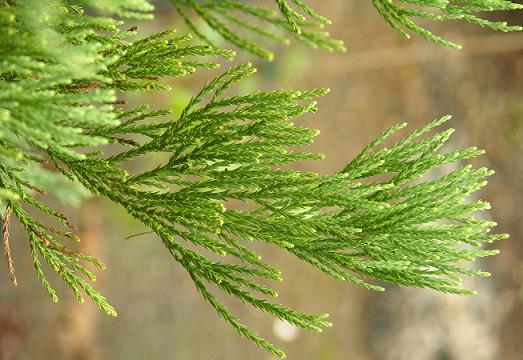 |
Description:The Giant Sequoia (Sequoiadendron giganteum) are the largest trees known to man. Larger than a dinosaur, bigger than a whale, as tall as a football field is long, these incredibly huge trees are now native to the coastal regions of Oregon and northern California. The largest living Giant Sequoia is the General Sherman Tree in the Giant Forest area of the Sequoia National Park in California. Standing at 274.9' (83.8 meters) tall, and 102.6' (31.3 meters) in circumference at its base, the General's wood is roughly equivalent to 180 miles of 2x4's. |
|||||||||||||||||||||||||||
|
Were this a harvestable lumber tree, its wood is enough to build over 40 houses, each with 5 rooms. Other trees in the world are taller: the tallest tree in the world is the Coast Redwood, which averages between 300' - 350' in height. Near Oaxaca, Mexico is a cypress which has a greater circumference, 162'. But in sheer mass, the General has no equal, and earns this tree the title of the World's Largest Living Thing. |
||||||||||||||||||||||||||||
|
Also known as the Big Trees or Ancient Ones, the Giant Sequoia is evergreen with fibrous bark. This bark is very unusual and plays a large part in the tree's survival over the centuries. The outer layer is made up of dead cells. It can measure 1 foot thick (General Sherman's bark is estimated at 4' thick!) and has very little resin which helps keep the trees safe from damage in forest fires. The bark also contains a natural tannic acid that is unpalatable to most insects and is very disease-resistant. The loss of lower branches reduces the fire ladder effect when there is a lack of understory trees, another way to limit fire damage. With very shallow root systems, 95% of the sequoias have roots no deeper than 3 meters. This explains why the big trees are so massive around the base, to avoid wind blow down. With these built-in preservation factors, we can see why the Big Trees can live so long--the oldest known fallen tree had approximately 3300 annual growth rings. Cones from each one of these trees hold an average of 200 seeds, very light in weight and they have wings to help them disperse in the wind. Sequoia cones are serotinous, releasing seed only when subjected to extreme heat. The cones of the Giant Sequoia are surprisingly small, obtaining a maximum length of only 9 cm. In weight, it is estimated that 91,000 seeds would equal one pound. They usually take over 2 years to mature, and may remain on the tree up to 20 years. |
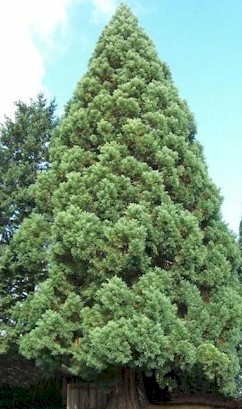 |
|||||||||||||||||||||||||||
|
As each tree produces an average 1,500 cones per year, a mature tree may hold up to 40,000 cones at any given time. Statistically, out of 40,000 cones, 1/3 are seedless. The rest are green and sheltered within the cone until fire or the long horned beetle (Phymatodes nitidus) causes the cones to open and release the seeds. When the forest surrounding the tree catches fire, hot air plumes into the tree canopy high above and dries the cones which then open and release their seeds. The beetle larvae, on the other hand, disconnect the seeds from the cone which triggers the dry-and-release mechanism. Another forest wildlife companion, the Douglas squirrel, or chickaree, (Tamiasciurus douglasii), is also a contributor to releasing the seeds as they feed on the fleshy part of the cones. |
||||||||||||||||||||||||||||
|
Although the squirrels and other rodents store cones for their winter food, most of those left buried will never take root. Of the seeds that do mature and fall to the ground, they must find bare mineral soil to germinate and full sun as they are shade intolerant. The lucky seeds falling onto the soil in a patch of sunlight must become firmly established before the dry Sierran summer comes. Once these tender youths are settled, their growth is very rapid. Habitat and Geographic Range: Eons of ever-warmer summers and cooler winters have almost decimated the Giant Sequoia and their cousins, the Coast Redwood of northern California and the re-established Dawn Redwood (Metasequoia glyptostroboides). Fossils of the giants have been found in the Petrified Forest in Arizona. Once ranged throughout northern America and Europe, these trees now grow naturally in more moist areas such as Oregon and California coasts. In an estimated 7 million years they have "traveled" from Colorado, Nevada and Wyoming to the east and the Santa Monica Mountains to the south and at this time the last of the great groves of the Giant Sequoia known to exist today are located on the western slopes of the Sierra Nevada from Placer County to southern Tulare County, California. Found at elevations of 4500 to 8400 ft, the groves are spread over many acres of forest land. At right: Photo of the front cover of John Muir's book, Our National Parks, first edition. This illustration shows Muir standing next to a Giant Sequoia. |
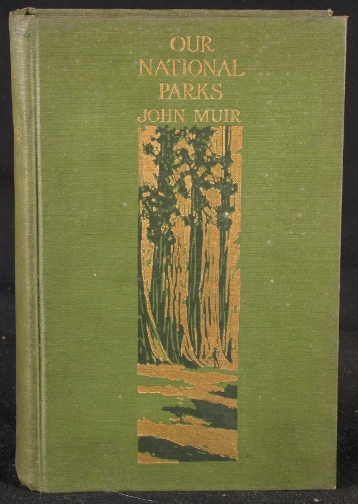 |
|||||||||||||||||||||||||||
Of course, they are still found in smaller groupings, mostly along the coastal regions of the northwestern United States where the coastal fogs provide the water which drips down to the soil level, giving clean, cool water to the roots below. |
||||||||||||||||||||||||||||
 Fun and educational, Sequoia Natural History Association's "Adopt a Giant Sequoia Kit" provides a hands-on experience for young and old alike. |
Showing a marked preference for deep well-drained soils, the Old Ones are more often found on the west side of mountain slopes in the 4,000 to 7,000 foot range. Although the summers may offer only drought conditions, the fog steps in when the winter rains and snow taper off. They can withstand temperatures from -10 to 95 degrees. This marks them hardy up to Plant Zone 6, and even higher zones if sheltered until the tender young trees are acclimated to colder regions. They do prefer full sun. |
|||||||||||||||||||||||||||
|
The biggest of the Big trees, the Giant Sequoia, may get up to 100 feet tall and three or four feet in diameter over 50 - 60 years span, but not realistically bigger than that. Uses of Plant: Giant Sequoia has excellent ornamental value, as specimen or feature trees or planted in groups. They make excellent windbreaks and privacy screens while still young (their fast growth is an added advantage). Their beautiful foliage and bark is a perfect backdrop for smaller shrubs with similar growing conditions. They do not require trimming as a rule, and their drought resistance make them fairly maintenance free once established. |
||||||||||||||||||||||||||||
|
Logging companies tried for many years to harvest the old growth giants, and played a major part in wiping out a large percentage of their population. Finally they concluded that the older trees were not cost-effective to harvest. Over 80% of the wood was lost due to the tendency of these Old Ones to shatter when they hit the ground. Now under the protection of national and state parks, cutting is no longer a concern. Instead, the logging companies learned to plant new trees specifically for cutting and they harvest them when young. Cut in their youth, the wood does make good shingles, fence posts, and landscape structures such as gazebos and trellis. The young-growth timber is comparable to other lumber species grown in the same general areas. Other uses: sometimes grown as Christmas trees; Native Americans traditionally use them for food, medicine, tools, and utensils; some modern medicinal uses. Propagation: Giant Sequoia may be propagated from seed or cuttings. |
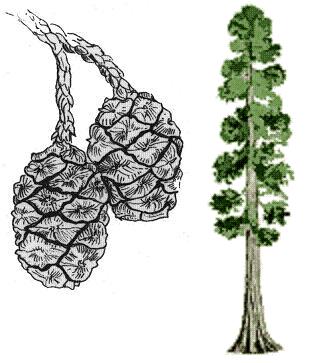
|
|||||||||||||||||||||||||||
|
Cuttings are best taken from trees less than 30 years old, but may be taken from older trees with limited success. Treat cut ends with a rooting hormone and place in damp earth or humus. Make sure they are kept slightly damp but well-drained until firmly rooted. Seeds which have been extracted from fresh, ripe cones should be soaked overnight in clear water. Pot in sand or well-drained soil and place in a cool area (do not let them dry out!) for about 60 days. |
||||||||||||||||||||||||||||
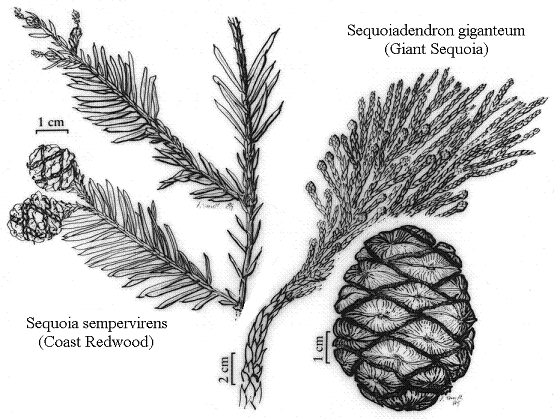 This drawing compares the two huge Sequoias |
Culture: Needs of the Old Ones are few: sun, well-drained soil, sufficient moisture when young and room to grow! They appreciate a nice shower during extremely dry spells.Pests and Diseases: Among the most fire, disease, and insect resistant trees known. Usually not harmed by disease, they are sometimes weakened when the roots are damaged and finally will blow down. Minimal problems with fungi.One insect which does cause problems is the Carpenter ant. They do not bother the trees directly but do facilitate entry of fungus and some beetles.The one pest most harmful to the giants is visitors. |
|||||||||||||||||||||||||||
|
In nurseries, either home or commercial, grey mold will sometimes attack the foliage and roots if care is not taken to give the young trees enough sun and air circulation. Root rot is sometimes a factor when the soil is not sufficiently well-drained.
Historical and
Special interest:
|
||||||||||||||||||||||||||||
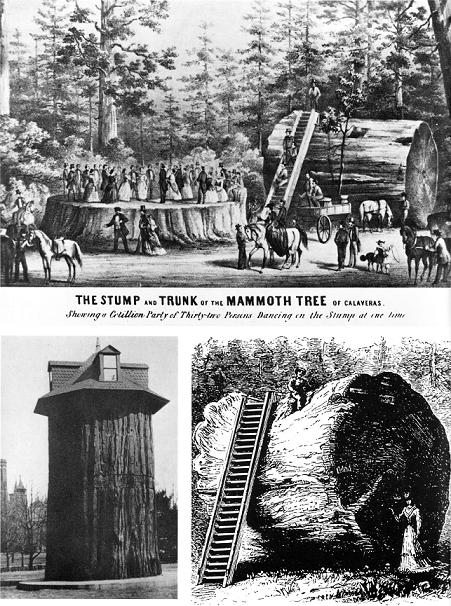 |
Origin of botanical name, original discovery info, etc.: The Sequoia, in both its forms (the coast Sequoia and the Giant Sequoia) is the state tree of California. The name Sequoia was chosen to honor the Cherokee nation leader Seqouyah, who invented an 86 character alphabet and taught his people to read and write their own language.The Giant Sequoias, or Ancient Ones, are highly significant in the community and culture of many forest Tribes. The youth learn a spiritual way to gain knowledge through fasting, holding sweats, and praying for the Ancient Ones to pass on knowledge of past generations (Schoenherr 1992).
|
|||||||||||||||||||||||||||
|
Top: Lithograph showing a party of 32 people dancing on the stump of the Discovery Tree, North Calaveras Grove. Bottom: 30-foot section of the General Noble Tree, which was displayed at the Columbian Exposition in Chicago in 1893 and later at the Mall in Washington, DC; it was subsequently taken to the US government's Arlington Experiment Farm, where it was "misplaced." These illustrations were scanned from: Hewes, J.J. 1984. Redwoods: The World's Largest Trees. Gallery Books. |
||||||||||||||||||||||||||||
|
Sequoyah (ᏍᏏᏉᏯ Ssiquoya, as he signed his name, or ᏎᏉᏯ Se-quo-ya,
as his name is often spelled today in Cherokee) (c. 1770–1843), named in English George Gist or George Guess, was a Cherokee
silversmith. In 1821 he completed his independent creation of a Cherokee syllabary, making reading and writing in Cherokee possible. This was the only time in
recorded history that a member of a non-literate people independently created an effective writing system.
After seeing its worth, the people of the Cherokee Nation rapidly began to use his syllabary and officially adopted it in 1825. Their
literacy rate quickly surpassed that of surrounding European-American settlers. At right, Sequoyah with a tablet depicting his writing system for the Cherokee language. 19th-century print of a painting. This image is in the public domain because its copyright has expired. |
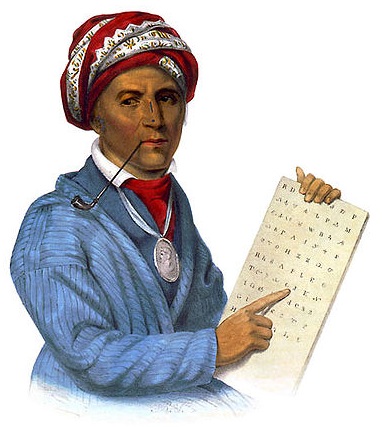 |
|||||||||||||||||||||||||||
|
||||||||||||||||||||||||||||
|
Photos We Share!
|
||||||||||||||||||||||||||||
|